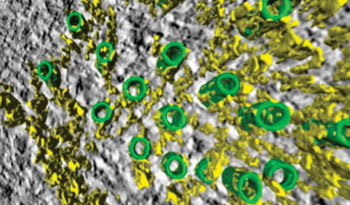Intracellular Mesh Supports the Mitotic Spindle During Cell Division
By LabMedica International staff writers
Posted on 20 Jul 2015
Three-dimensional electron microscopy has revealed the existence of an intracellular mesh that supports cell division by maintaining the correct geometrical spacing of the chromosomes at the mitotic spindle.Posted on 20 Jul 2015
Kinetochore fibers (K-fibers) of the mitotic spindle are force-generating units that power chromosome movement during mitosis. K-fibers are composed of many microtubules that are held together throughout their length.

Image: A three-dimensional vies view of the mesh: microtubules (green tubes) of the mitotic spindle are held together by a yellow network, the mesh (Photo courtesy of the University of Warwick).
When they switched from two-dimensional to three-dimensional electron microscopy, investigators at the University of Warwick (United Kingdom) discovered that K-fiber microtubules (MTs) were connected by a network of MT connectors. The investigators called this network "the mesh" and described it as being made of linked multipolar connectors. Each connector had up to four struts, so that a single connector could link up to four MTs.
While optimal stabilization of K-fibers by the mesh was required for normal progression through mitosis, the investigators reported in the June 19, 2015, online edition of the journal eLife that molecular manipulation of the mesh by overexpression of TACC3 (transforming, acidic coiled-coil containing protein 3) caused disorganization of the K-fiber MTs. TACC3 is a motor spindle protein that is thought to play a role in stabilization of the mitotic spindle. This protein may also play a role in growth a differentiation of certain cancer cells.
Senior author Dr. Stephen J. Royle, associate professor of biomedical cell biology at the University of Warwick, said, "We had been looking in two-D and this gave the impression that "bridges" linked microtubules together. This had been known since the 1970s. All of a sudden, tilting the fiber in three-D showed us that the bridges were not single struts at all but a web-like structure linking all the microtubules together."
"As a cell biologist you dream of finding a new structure in cells but it is so unlikely," said Dr. Royle. "Scientists have been looking at cells since the 17th Century and so to find something that no-one has seen before is amazing."
Related Links:
University of Warwick










 (3) (1).png)


